Authentication
Authentication options
Primary Authentication: Zephyr Enterprise provides multiple options for authenticating users when they log into the system. This is referred to as Primary Authentication.
Secondary Authentication: If LDAP/Crowd/Webservice/SSO is being used for primary authentication and certain temporary/migrant/external users not in those systems need access to Zephyr, the secondary authentication option can be turned on to allow that.
Important
Please note that this process is only for authentication and not for synchronizing user information with these systems. After completing authentication, you may import Groups by following the instructions in Group Setup.
Primary Authentication
Internal
Administrators can leave the selection at 'Internal' to use the native Zephyr authentication system. The user ID and passwords stored in the User Setup section are used to authenticate users.
This is the default option.
Users can reset their own passwords by clicking on the 'Profile' link in the top right corner of their interface.
LDAP
LDAP (Lightweight Directory Access Protocol) is an Internet protocol that web applications can use to look up information about those users and groups from the LDAP server. An LDAP directory is a collection of data about users and groups.
If your organization is using an LDAP server for authentication, the Zephyr server can be set up to authenticate users using LDAP.
Zephyr Enterprise supports the most popular LDAP directory servers:
Microsoft Active Directory
Apache Directory Server (ApacheDS)
OpenDS
OpenLDAP
A generic LDAP directory server
Both LDAP and LDAPS (secure LDAP) are supported.
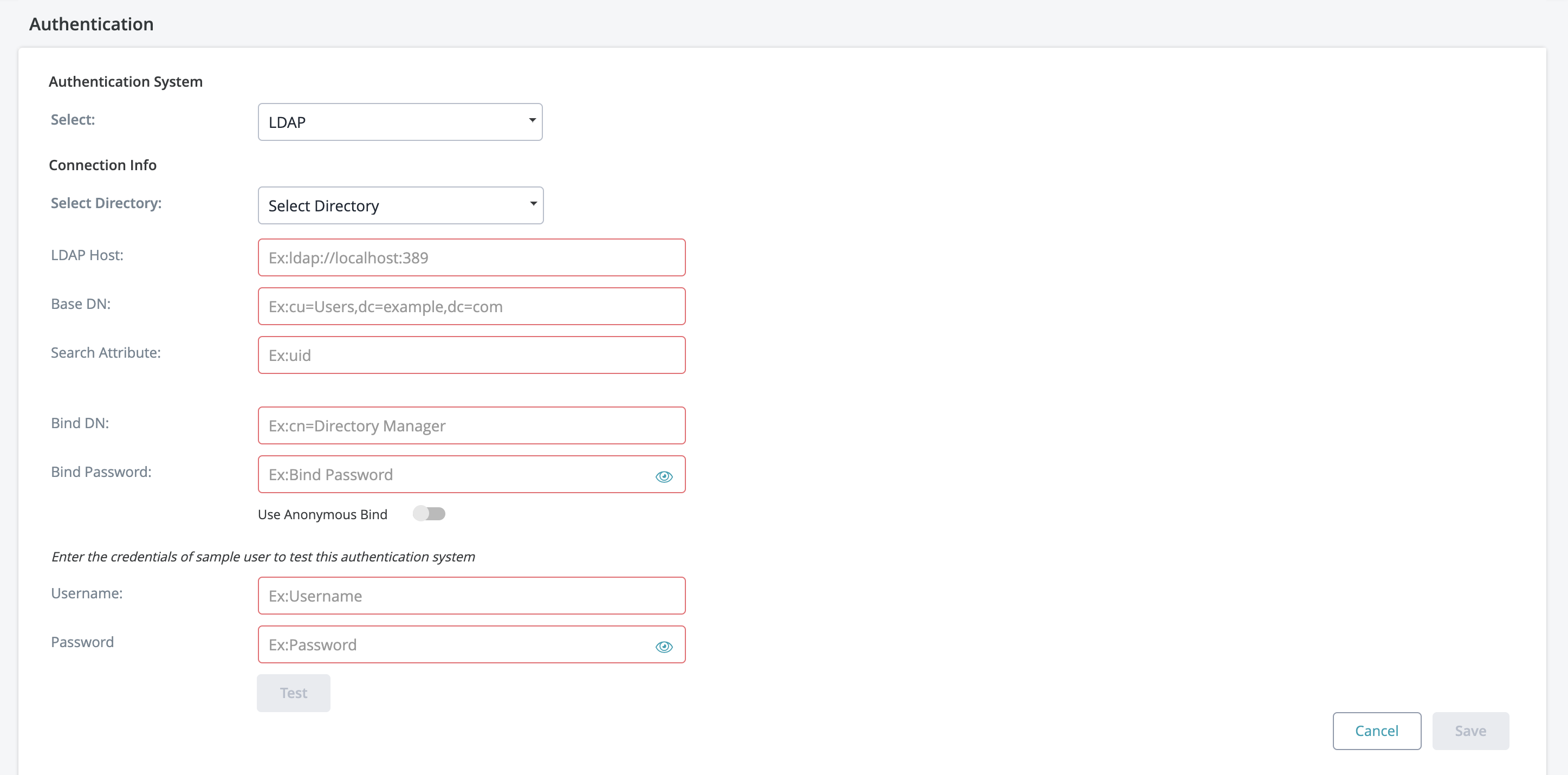 |
LDAP Configuration
Connecting to an LDAP Directory in Jira
Select Administration.
Choose Authentication.
Add a directory and select one of these types:
'LDAP' – You will be able to choose a specific LDAP directory type on the next screen.
Enter the values for the settings as described below.
Save the directory settings.
Server Settings
Setting | Description |
|---|---|
Directory Type | Select the type of LDAP directory that you will connect to. If you are adding a new LDAP connection, the value you select here will determine the default values for many of the options on the rest of the screen. Examples:
|
Hostname | Your LDAP server in the format
Note: If you use LDAPS (secure LDAP) and your LDAPS server uses a self-signed certificate, you must configure Zephyr to trust this certificate. See the instructions below. |
Base DN | The root distinguished name (DN) to use when running queries against the directory server. Examples:
For Microsoft Active Directory, specify the base DN in the following format: dc=domain1,dc=local. You will need to replace the domain1 and local for your specific configuration. Microsoft Server provides a tool called ldp.exe, which is useful for finding out and configuring your server's LDAP structure. |
Bind DN | The distinguished name of the user that the application will use when connecting to the directory server. Examples:
|
Bind Password | The password of the user-specified above. |
Search Attribute | The attribute field to use when loading the username. Examples:
|
Advance Settings
User Schema Settings
Setting | Description |
|---|---|
Search Attribute | The attribute field to use when loading the username. Examples:
|
User Object Class | This is the name of the class used for the LDAP user object. Example:
|
User Object Filter | The filter to use when searching user objects. Example:
|
User First Name Attribute | The attribute field to use when loading the user's first name. Example:
|
User Last Name Attribute | The attribute field to use when loading the user's last name. Example:
|
User Email Attribute | The attribute field to use when loading the user's email address. Example:
|
Group Schema Settings
Setting | Description |
|---|---|
Group Object Class | This is the name of the class used for the LDAP group object. Examples:
|
Group Object Filter | The filter to use when searching for group objects. Example:
|
Group Name Attribute | The attribute field to use when loading the group's name. Example:
|
Group Description Attribute | The attribute field to use when loading the group's description. Example:
|
Membership Schema Settings
Setting | Description |
|---|---|
Group Members Attribute | The attribute field to use when loading the group's members. Example:
|
User Membership Attribute | The attribute field to use when loading the user's groups. Example:
|
Using LDAPS with a Self-Signed Certificate
If your LDAPS server uses a self-signed certificate or a certificate signed by a private CA, you need to add it to the Java cacerts file on your Zephyr server. The cacerts file contains the trusted certificates.
To add your LDAPS certificate to cacerts, run the following command on your Zephyr server, replacing the paths with your own.
On Windows:
keytool -importcert -alias "ldapsCer"
-keystore "C:\Program Files\Java\jre1.8.0_231\lib\security\cacerts"
-file "C:\Users\Administrator\Documents\ldapsCer.cer"Note
The line breaks above are added for readability. The entire command must be written on one line.
On Linux:
keytool -importcert -alias "ldapsCer"
-keystore "/usr/java/jdk1.8.0_144/jre/lib/security/cacerts"
-file "/home/ldapsCer.cer"Anonymous Bind
When setting up your LDAP connection, we provide you with an option to connect without requiring the Bind DN and Bind Password. To connect to LDAP without requiring this information, enable the Anonymous Bind feature when setting up LDAP.
Anonymous Bind is essentially an LDAP server function that allows the client to connect and search the directory (bind and search) without requiring the Bind DN and Bind Password.
To use Anonymous Bind, click on the checkbox to ensure it is enabled during the LDAP connection setup process.
Below the Connection Info section there will be a place to test the connections and LDAP credentials used. This is useful for a quick check to see if everything is working. The username and password here can be a user in your directory that you wish to log on the Zephyr system with. Once the information is correct you can click the Test button and if everything goes correctly, you should see a 'Validation Successful!' popup. Otherwise, start troubleshooting the setup.
LDAP Required Fields
1. What are the required fields for connecting to LDAP?
Open DS: LDAP Host, Base DN, and Search Attribute are required.
The username and password for users who can authenticate are required.
Active Directory: LDAP Host, Base DN, and Search Attribute.
The username and password for users who can authenticate are required.
2. Is a unique Organizational Unit needed for Zephyr? (Organization Unit can be - Zephyr)
The organizational unit can be any name. It does not necessarily have to be specific to Zephyr.
3. Is Bind DN required?
Bind DN is required for Active Directory.
Bind DN is not required for Open DS.
Tip
LDAP Setup Details and Example
Note
Once the LDAP Authentication is successful, if you want to import LDAP Groups (which contain external LDAP users), please go through Group Setup.
Previously, when users set up their authentication for LDAP, the option to import groups would immediately be available in a pop-up. This is now moved to the Import Groups tab within the Group Setup page under Administration.
The newly added Import Groups tab now displays which authentication system is connected (LDAP).
Crowd
If your organization is using a Crowd server for authentication, the Zephyr Server can be set up to authenticate with Crowd before allowing users to log into the system.
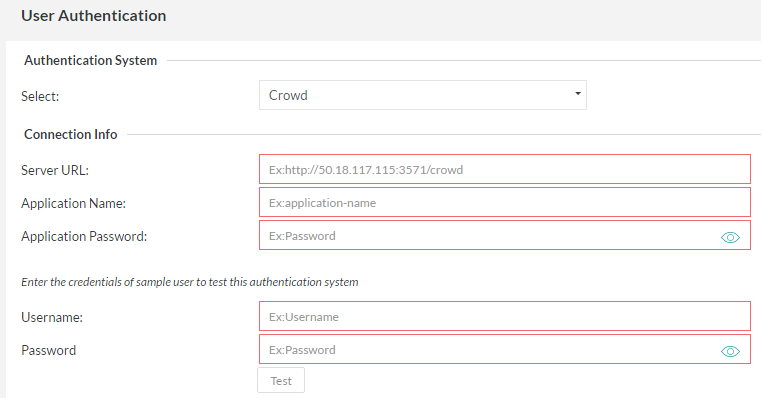 |
After entering the relevant 'Connection Info', the authentication can be tested by entering the username and password of a user and clicking on the 'Test' button. This provides feedback on whether the authentication system was reachable and if the authentication was successful or a failure.
Note
Once the Crowd Authentication successful, if you want to import Crowd Groups(which contains external Crowd users) please go through Group Setup.
Previously, when users set up their authentication for Crowd, the option to import groups would be available right away in a pop-up. This is now moved to the Import Groups tab within the Group Setup page under Administration.
The newly added Import Groups tab now displays which authentication system is connected (Crowd).
WebService
If your organization is using a different authentication system, then you could write a WebService that the Zephyr Server can call to authenticate against before allowing users to log into the system.
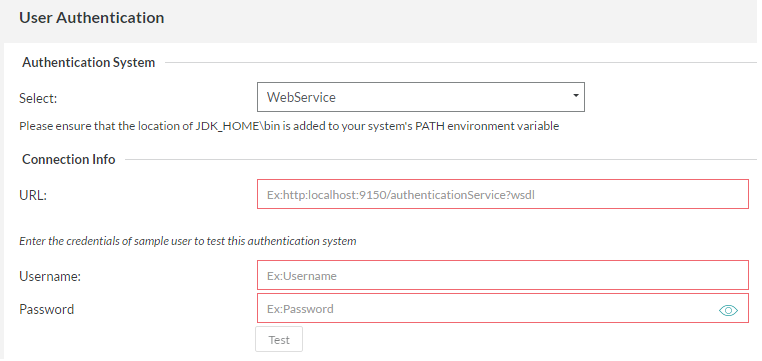 |
After entering the relevant 'Connection Info', the authentication can be tested by entering the username and password of a user and clicking on the 'Test' button. This provides feedback on whether the authentication system was reachable and if the authentication was successful or a failure.
Single Sign-On (SSO) with SAML 2.0
If your organization is using Single Sign-On (SSO) for authentication, the Zephyr Server can be set up to authenticate with it before allowing users to log into the system.
With SSO set up and enabled, the login flow will redirect you straight to the SSO login page and after entering the correct credentials, it will redirect and log you into Zephyr. This minimizes the amount of steps and redirects to get logged into Zephyr.
You can enable Auto-Provisioning when setting up your SSO.
Auto-Provisioning will automatically create a user account for any new user who attempts to log in to Zephyr with SSO.
New user accounts created this way will only receive the Dashboard User Role, and these accounts will not consume a license.
This can be enabled/disabled on the Authentication page under the Administration section of Zephyr.
To enable this, you must combine the SAML attributes from your external SSO system with the Zephyr attributes so that Zephyr can automatically create users.
See below for the configuration fields required for setting up SSO:
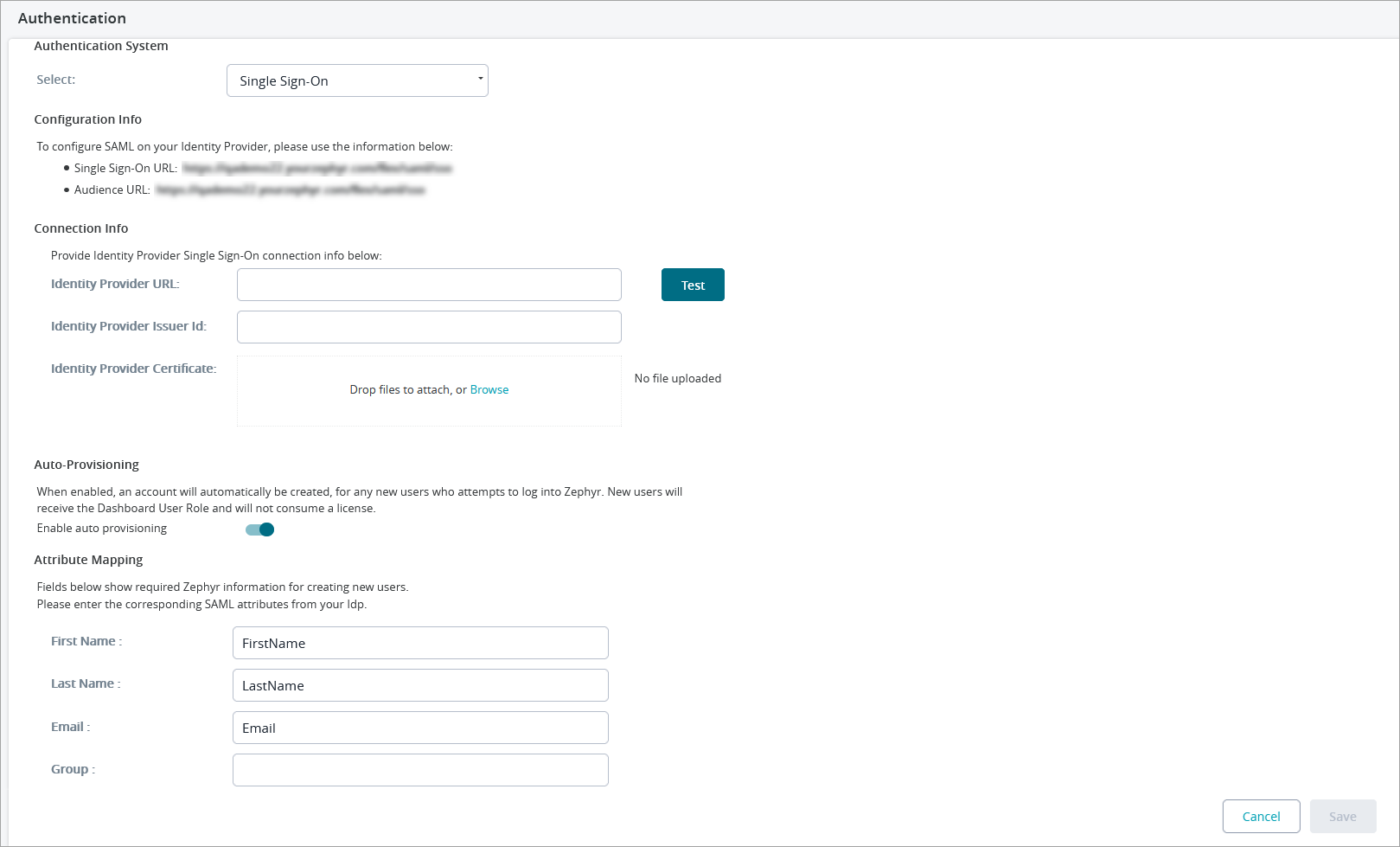 |
Notice
The Test button allows you to check the specified URL. Clicking the button opens a new tab. If the login page of your SSO provider is opened in the tab, you have specified the correct URL.
If SSO is configured incorrectly, users will not be able to connect to Zephyr. To bypass SSO authentication, the administrator can navigate to the following URL:
http(s)://<server>:<port>/flex/html5/internal-loginand log in using the login and password of the account with the user ID 1 (userId=1). By default, both the login and password of the account aretest.manager.
For an example of setting up Okta in Zephyr, please refer to SSO Setup with Okta in Zephyr.
For an example of setting up Azure AD in Zephyr, please refer to SSO Setup with Azure AD in Zephyr.
Secondary Authentication
If LDAP/Crowd/Webservice/SSO is being used for primary authentication and certain temporary/migrant/external users are not in those systems and need access to Zephyr, the secondary authentication option can be turned on to allow that.
Those users are then authenticated based on the user ID and password set up for them in the User Setup section.
To enable secondary authentication:
Go to Administration > System Setup > Customizations.
Click Miscellaneous in the Advanced section.
Select the Enable Secondary Authentication check box in the subsequent dialog and click Save.
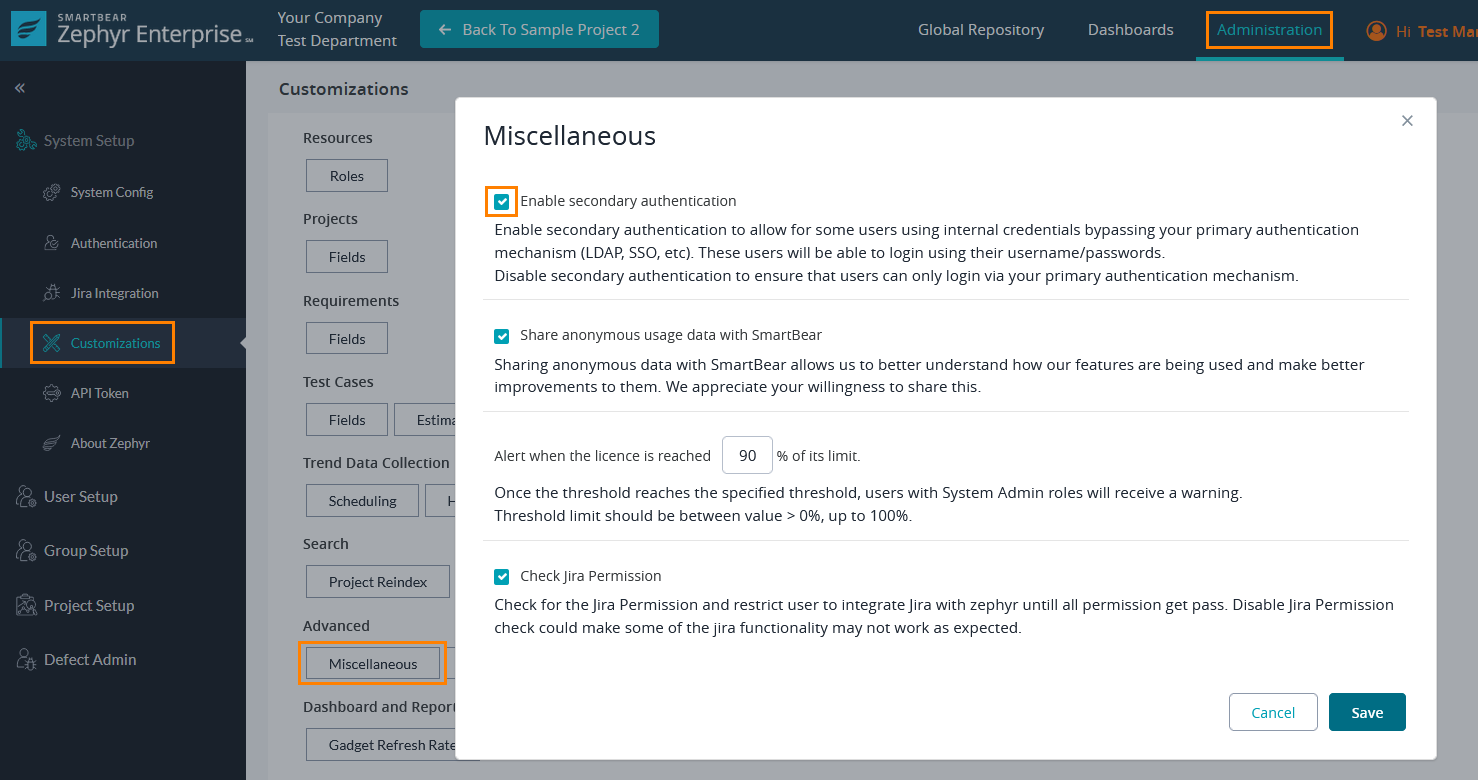 |